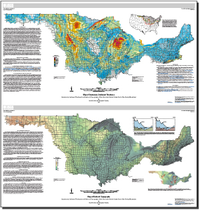Quaternary sediment thickness and bedrock topography of the glaciated United States east of the Rocky Mountains
Links
- Sheets:
- Sheet 1 (10 MB pdf) – Map of Quaternary Sediment Thickness
- Sheet 2 (13 MB pdf) – Map of Bedrock Topography
- Metadata:
- Sheet 1 Metadata (30 KB txt)
- Sheet 1 Metadata (30 KB)
- Sheet 2 Metadata (30 KB txt)
- Sheet 2 Metadata (30 KB)
- Metadata Package (30 KB zip) - Zip file of Sheet 1 and 2 metatdata
- Read Me: Read Me (2 KB txt)
- Spatial Data: Spatial Data (16 MB zip) – Contains raster image files, layer file, and metadata
- Download citation as: RIS | Dublin Core
Abstract
Beginning roughly 2.6 million years ago, global climate entered a cooling phase known as the Pleistocene Epoch. As snow in northern latitudes compacted into ice several kilometers thick, it flowed as glaciers southward across the North American continent. These glaciers extended across the northern United States, dramatically altering the landscape they covered. East of the Rocky Mountains, the ice coalesced into continental glaciers (called the Laurentide Ice Sheet) that at times blanketed much of the north-central and northeastern United States. To the west of the Laurentide Ice Sheet, glaciers formed in the mountains of western Canada and the United States and coalesced into the Cordilleran ice sheet; this relatively smaller ice mass extended into the conterminous United States in the northernmost areas of western Montana, Idaho, and Washington. Throughout the Pleistocene, landscape alteration occurred by (1) glacial erosion of the rocks and sediments; (2) redeposition of the eroded earth materials in a form substantially different from their source rocks, in terms of texture and overall character; and (3) disruption of preexisting drainage patterns by the newly deposited sediments. In many cases, pre-glacial drainage systems (including, for example, the Mississippi River) were rerouted because their older drainage courses became blocked with glacial sediment.
The continental glaciers advanced and retreated many times across those areas. During each ice advance, or glaciation, erosion and deposition occurred, and the landscape was again altered. Through successive glaciations, the landscape and the bedrock surface gradually came to resemble their present configurations. As continental ice sheets receded and the Pleistocene ended, erosion and deposition of sediment (for example in stream valleys) continued to shape the landscape up to the present day (albeit to a lesser extent than during glaciation). The interval of time since the last recession of the glaciers is called the Holocene and, together with the Pleistocene, constitutes the Quaternary Period of geologic time; this publication characterizes the three-dimensional geometry of the Quaternary sediments and the bedrock surface that lies beneath.
The pre-glacial landscape was underlain mostly by weathered bedrock generally similar in nature to that found in many areas of the non-glaciated United States. Glacial erosion and redeposition of earth materials produced a young, mineral-rich soil that formed the basis for the highly productive agricultural economy in the U.S. midcontinent. Extensive buried sands and gravels within the glacial deposits also provided a stimulus to other economic sectors by serving as high-quality aquifers supplying groundwater to the region’s industry and cities. An understanding of the three-dimensional distribution of these glacial sediments has direct utility for addressing various societal issues including groundwater quality and supply, and landscape and soil response to earthquake-induced shaking.
The Quaternary sediment thickness map and bedrock topographic map shown here provide a regional overview and are intended to supplement the more detailed work on which they are based. Detailed mapping is particularly useful in populated areas for site-specific planning. In contrast, regional maps such as these serve to place local, detailed mapping in context; to permit the extrapolation of data into unmapped areas; and to depict large-scale regional geologic features and patterns that are beyond the scope of local, detailed mapping. They also can enhance the reader’s general understanding of the region’s landscape and geologic history and provide a source of information for regional decision making that could benefit by improved predictability of bedrock depth beneath the unconsolidated Quaternary sediments. To enable these maps to be analyzed in conjunction with other types of information, this publication also includes the map data in GIS compatible format.
Suggested Citation
Soller, D.R., and Garrity, C.P., 2018, Quaternary sediment thickness and bedrock topography of the glaciated United States east of the Rocky Mountains: U.S. Geological Survey Scientific Investigations Map 3392, 2 sheets, scale 1:5,000,000. https://doi.org/10.3133/sim3392.
ISSN: 2329-132X (online)
Study Area
Table of Contents
- Introduction
- Source Data and Methods
- Land-Surface Topography and Bathymetry
- Map of Quaternary Sediment Thickness
- Map of Bedrock Topography
- Discussion of Map Features
- References
- Data Sources
| Publication type | Report |
|---|---|
| Publication Subtype | USGS Numbered Series |
| Title | Quaternary sediment thickness and bedrock topography of the glaciated United States east of the Rocky Mountains |
| Series title | Scientific Investigations Map |
| Series number | 3392 |
| DOI | 10.3133/sim3392 |
| Publication Date | January 26, 2018 |
| Year Published | 2018 |
| Language | English |
| Publisher | U.S. Geological Survey |
| Publisher location | Reston, VA |
| Contributing office(s) | National Cooperative Geologic Mapping and Landslide Hazards |
| Description | 2 Sheets: 42.5 x 23.0 inches; Metadata; Read Me; Spatial Data |
| Country | United States |
| Online Only (Y/N) | Y |
| Additional Online Files (Y/N) | Y |


